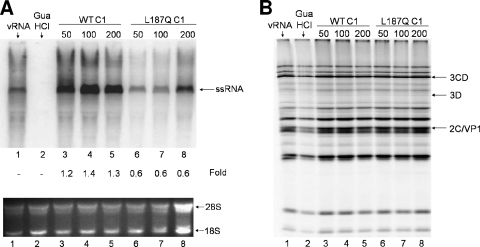FIG. 7.
Stimulation of poliovirus RNA synthesis by the addition of wild-type (WT) hnRNP C1 proteins. Recombinant wild-type hnRNP C1 (lanes 3 to 5) or hnRNP C1-L187Q (lanes 6 to 8) protein or protein buffer alone (lane 1) was added to in vitro replication/translation reaction mixtures containing HeLa S10 cytoplasmic extracts from uninfected cells. Each reaction mixture was split into two fractions as described previously (15). (A) Replication of poliovirus virion RNA. Replication fractions containing purified poliovirus vRNA, HeLa S10 cytoplasmic extracts, and recombinant hnRNP C proteins were incubated at 30°C to allow translation of nonstructural proteins. Following addition of [32P]CTP to the reaction mixtures, RNA synthesis was allowed to proceed for 2 h. The replication reaction mixtures were then purified using an RNaqueous spin column and resolved on a 1.1% Tris-borate-EDTA-agarose gel containing ethidium bromide. As a negative control, 2 mM guanidine hydrochloride (GuaHCl) was added to the reaction mixture shown in lane 2 to inhibit negative-strand RNA synthesis. 18S and 28S rRNAs were used to confirm equal loading of samples. Comparative density values of the signals for RNA synthesis are depicted as fold increases compared to lane 1. (B) Translation fractions of the samples depicted in panel A were incubated with [35S]methionine and, following incubation at 30°C for 4 h, the reaction mixtures were boiled in Laemmli sample buffer and resolved on a 12.5% polyacrylamide-SDS-containing gel.

